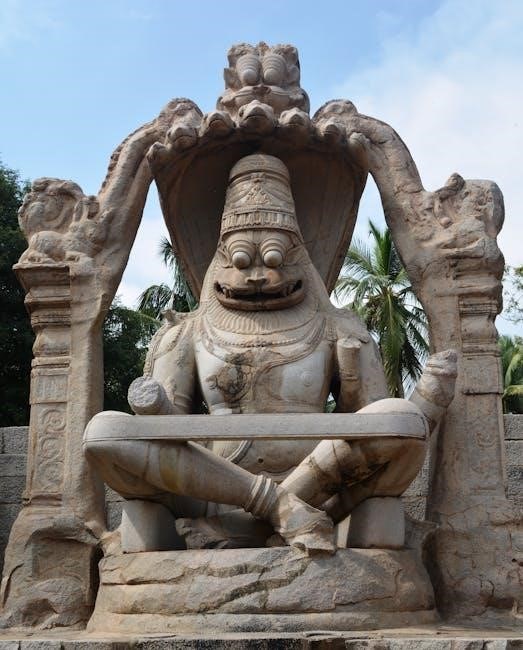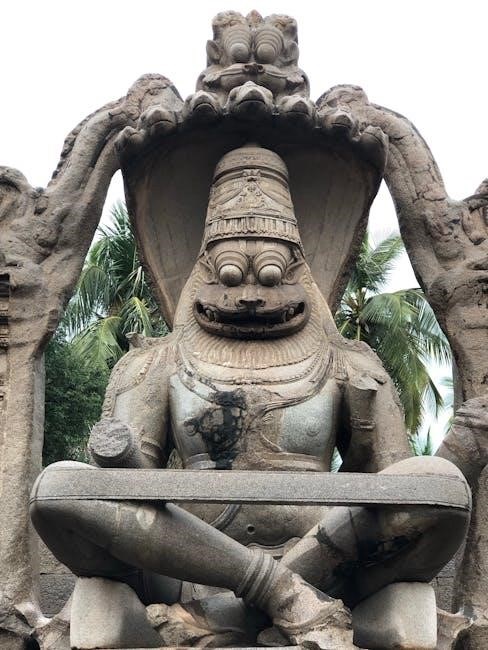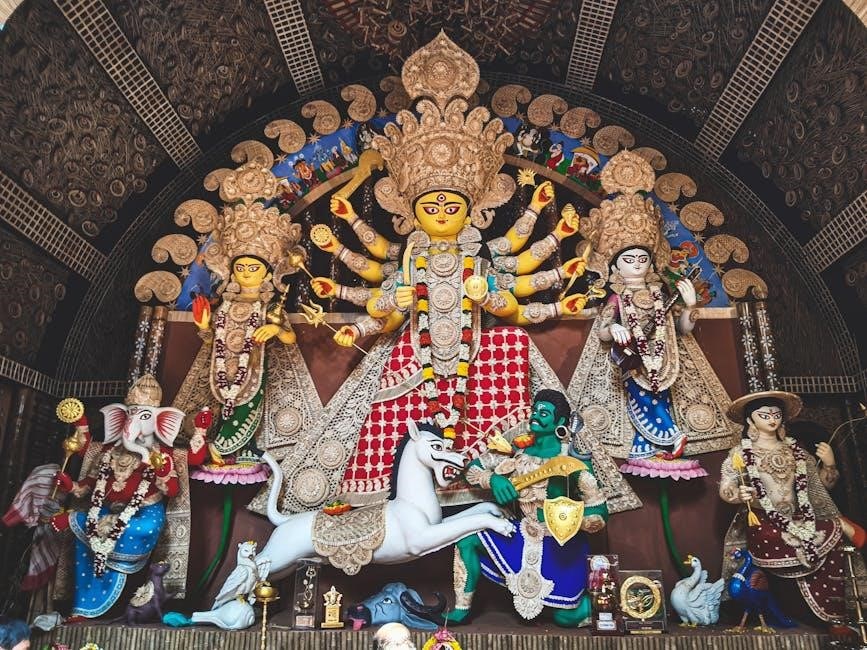Lakshmi Ashtakam is a divine 8-verse hymn dedicated to Goddess Lakshmi, praising her attributes and invoking her blessings for wealth, prosperity, and spiritual growth․ It is often recited during auspicious occasions like Diwali and Lakshmi Puja, offering devotees a powerful way to connect with her divine grace and seek protection from adversity․ The hymn, sourced from the Padma Purana, is a beloved prayer among followers, emphasizing her role as the destroyer of evil and the granter of boons, making it a cornerstone of devotional practices․

Significance of Lakshmi Ashtakam
Lakshmi Ashtakam holds immense spiritual and cultural significance as a devotional hymn dedicated to Goddess Lakshmi, the embodiment of wealth, prosperity, and divine energy․ It is widely revered for its ability to bestow material prosperity and spiritual growth upon devotees․ The hymn is particularly significant during auspicious occasions such as Diwali and Lakshmi Puja, where it is chanted to invoke the goddess’s blessings and protection․ Its verses extol Lakshmi’s divine attributes, emphasizing her role as the destroyer of evil, the granter of boons, and the primordial energy sustaining the universe․ Reciting the Ashtakam with devotion is believed to destroy sins, ego, and adversity, fostering inner peace and fulfillment․ It is also a powerful tool for spiritual invocation, connecting devotees with the divine feminine energy․ The hymn’s significance lies in its universal appeal, making it a cherished prayer across cultures and generations, symbolizing the eternal quest for harmony and prosperity․
Historical Background of Lakshmi Ashtakam
The Lakshmi Ashtakam is an ancient Sanskrit hymn deeply rooted in Hindu scripture and tradition․ It is sourced from the Padma Purana, one of the eighteen major Puranas, and is attributed to Lord Indra, who is said to have chanted it in praise of Goddess Lakshmi․ This sacred hymn has been passed down through generations, becoming an integral part of devotional practices․ Its historical significance is underscored by its mention in various religious texts and its widespread use in rituals and festivals․ The Ashtakam’s composition reflects the reverence for Lakshmi as the embodiment of wealth, prosperity, and divine energy․ Over time, it has evolved into a cornerstone of worship, particularly during auspicious occasions like Diwali and Lakshmi Puja․ Its enduring popularity highlights its cultural and spiritual importance, making it a cherished prayer for millions of devotees seeking blessings and protection․ The hymn’s historical roots and scriptural authority have solidified its place in Hindu tradition․

Structure and Composition of Lakshmi Ashtakam
Lakshmi Ashtakam is an 8-verse Sanskrit hymn, each verse glorifying a distinct aspect of Goddess Lakshmi, such as her role in destroying evil, granting boons, and embodying primordial energy․ The hymn begins with Indra’s praise of her divine attributes, emphasizing her significance as a symbol of wealth and prosperity․ Each verse is structured to evoke devotion and invoke her blessings, making it a spiritually profound composition․ The hymn’s rhythmic and poetic structure has made it a beloved prayer for recitation during pujas and festivals․
Overview of the Hymn
Lakshmi Ashtakam, a sacred 8-verse hymn, is a devotional ode to Goddess Lakshmi, extolling her divine virtues and universal benevolence․ Originating from the Padma Purana, it is attributed to Lord Indra, who praises her as the embodiment of wealth, prosperity, and spiritual enlightenment․ Each verse intricately weaves themes of devotion, worship, and the pursuit of divine grace, emphasizing her role as a destroyer of evil, granter of boons, and the primordial energy sustaining the cosmos․ The hymn is structurally elegant, with each stanza building upon theprevious one, creating a crescendo of reverence․ Its rhythmic and lyrical composition makes it accessible for recitation during pujas, festivals, and personal worship․ By chanting the Lakshmi Ashtakam, devotees seek not only material prosperity but also spiritual growth and protection from adversity, making it a cornerstone of Hindu devotional practices․ Its universal appeal lies in its ability to inspire faith and harmony, connecting believers with the divine essence of Goddess Lakshmi․
Verse 1: Indra’s Praise
Verse 1 of Lakshmi Ashtakam begins with Indra, the king of the gods, offering his reverence to Goddess Lakshmi․ The verse, “Indra uvācha: Namosthesthu Maha Maye, Sree peede, sura poojithe, Sanka, chakra, Gadha hasthe, Maha Lakshmi Namosthuthe,” highlights her divine attributes and her revered status․ It describes Lakshmi as seated on a lotus, worshipped by the gods, and holding the conch, discus, and mace—symbols of her power and protection․ This opening verse sets the tone for the hymn, establishing Lakshmi as the supreme embodiment of wealth, prosperity, and divine energy․ By invoking her with such reverence, Indra exemplifies the devotion and awe that the hymn inspires in its reciters․ This verse is often considered a powerful invocation, drawing the listener into the sacred space of worship and connection with the divine feminine․ It underscores Lakshmi’s universal appeal and her role as a protector and benefactor of all beings․
Verse 2: destroyer of evil
Verse 2 of Lakshmi Ashtakam, “Namaste Garuḍārūḍhe Olāsura Bhayaṅkari,” glorifies Goddess Lakshmi as the destroyer of evil forces and the remover of fears․ This verse emphasizes her role as a fierce protector who eradicates negativity and adversity․ Lakshmi is depicted as riding Garuḍa, the celestial eagle, symbolizing her power to transcend and vanquish evil․ The verse highlights her ability to instill courage and peace in the hearts of her devotees․ By praising her as “Olāsura Bhayaṅkari,” the hymn underscores her fearless nature in confronting and annihilating evil․ This verse is particularly significant for those seeking protection from negative energies and challenges․ Reciting it with faith is believed to invoke Lakshmi’s protective grace, offering solace and strength in times of adversity․ The imagery of Lakshmi as a powerful protector resonates deeply with devotees, reinforcing her divine role in maintaining harmony and prosperity in the universe;
Verse 3: Granter of Boons
Verse 3 of Lakshmi Ashtakam, “Sarvapāpahare Devi Mahālakṣmi Namōstu Te,” highlights Goddess Lakshmi’s role as the granter of boons and the remover of all sins․ This verse is a heartfelt plea to the goddess, seeking her divine intervention in fulfilling desires and granting wisdom․ Devotees believe that by reciting this verse with devotion, Lakshmi bestows her grace, leading to material prosperity and spiritual enlightenment․ The verse emphasizes her benevolent nature, as she is often depicted as a compassionate mother who listens to the prayers of her devotees․ It also underscores the belief that her blessings are not limited to wealth but extend to the fulfillment of righteous desires and the attainment of inner peace․ This verse is particularly cherished for its ability to inspire hope and faith in those seeking her divine assistance․ Its recitation is considered a powerful way to connect with Lakshmi’s nurturing energy and seek her guidance in navigating life’s challenges․
Verse 4: Primordial Energy
Verse 4 of Lakshmi Ashtakam, “Sarvasiddhi Mayi Namastute,” glorifies Goddess Lakshmi as the embodiment of primordial energy and the source of all accomplishments․ This verse underscores her role as the dynamic force behind cosmic evolution, sustaining creation and maintaining balance in the universe․ Lakshmi is revered here as the energy that drives life and governs the natural order, making her indispensable to the functioning of the cosmos․ Her association with Lord Vishnu further emphasizes her role as the active principle of the divine, complementing his passive essence․ The verse also highlights her cosmic dance, symbolizing the rhythmic interplay of creation and preservation․ By reciting this verse, devotees seek to harness her energizing presence, believing it will vitalize their lives and inspire them to achieve their goals․ It is a celebration of her omnipresent and life-sustaining power, reinforcing her status as the ultimate source of energy and vitality․ This verse is particularly cherished for its profound philosophical insights into Lakshmi’s cosmic role․
Verse 5: Symbolism in the Hymn
Verse 5 of Lakshmi Ashtakam is rich in symbolism, highlighting Goddess Lakshmi’s divine attributes and her role in the cosmic order․ The verse describes her as seated on a lotus throne, symbolizing her purity and spiritual growth․ The lotus, untouched by impurities, represents her transcendence and divine nature․ Her four arms, adorned with lotuses, signify her power to grant boons, protect devotees, and sustain life․ The elephants bathing her with water from golden vessels symbolize prosperity and royal benevolence․ The hymn also portrays her as the embodiment of cosmic energy, nurturing all creation; The imagery of her serene smile and radiant form evokes feelings of devotion and awe․ The verse underscores her role as the sustainer of the universe, emphasizing her maternal compassion and grace․ These symbols collectively create a vivid and reverent portrayal of Lakshmi, inspiring devotees to seek her blessings for spiritual and material well-being; The rich symbolism in this verse makes it a profound reflection of her divine essence․
Verse 6: Devotional Significance
Verse 6 of Lakshmi Ashtakam holds profound devotional significance, emphasizing the deep emotional connection between the devotee and Goddess Lakshmi․ This verse is a heartfelt plea to the goddess, expressing surrender and devotion, seeking her refuge and grace․ It highlights the importance of self-surrender and the dissolution of ego, which are essential for true spiritual growth․ The verse also underscores the belief that Goddess Lakshmi’s blessings are not just material but also spiritual, offering protection from life’s challenges and fostering inner peace․ Devotees recite this verse with immense faith, believing it strengthens their bond with the divine․ The emotional depth of this verse resonates deeply, making it a powerful tool for those seeking solace, guidance, and prosperity․ By chanting this verse, one invokes Lakshmi’s benevolent presence, seeking her assistance in navigating life’s journey and attaining both worldly and spiritual fulfillment․ Its devotional significance lies in its ability to inspire hope, faith, and a profound sense of connection to the divine․
Verse 7: Spiritual Invocation
Verse 7 of Lakshmi Ashtakam is a profound spiritual invocation, serving as a heartfelt plea to Goddess Lakshmi to bestow her divine grace and guidance․ This verse emphasizes the importance of seeking spiritual enlightenment and inner fulfillment through devotion․ It highlights the goddess’s role as a source of wisdom and enlightenment, urging devotees to surrender their ego and worldly attachments․ The verse is often chanted during meditation and poojas, creating a sacred atmosphere for spiritual growth․ By reciting this verse, believers seek to dispel ignorance and negative thoughts, inviting Goddess Lakshmi’s divine light into their lives․ Its spiritual invocation is believed to bring clarity of mind and a deeper connection to the divine․ The verse also underscores the transformative power of devotion, helping individuals navigate life’s challenges with faith and resilience․ Its universal appeal lies in its ability to inspire spiritual awakening and harmony, making it a cherished part of devotional practices for those seeking enlightenment․
Verse 8: Universal Appeal
Verse 8 of Lakshmi Ashtakam highlights the universal appeal of Goddess Lakshmi, emphasizing her role as a divine force accessible to all․ This verse underscores the idea that Lakshmi’s blessings are not limited to material wealth but encompass spiritual harmony and inner peace․ It resonates with devotees from diverse backgrounds, transcending cultural and linguistic barriers․ The verse is often praised for its inclusive nature, making it a unifying prayer for those seeking prosperity and balance in life․ By invoking Lakshmi’s universal grace, it fosters a sense of togetherness and shared devotion among worshippers․ The verse also reflects the belief that true prosperity lies in harmony with the divine and the world around us․ Its universal appeal is further evident in its popularity across various regions and languages, making it a cherished hymn in global devotional practices; This final verse serves as a reminder of Lakshmi’s boundless compassion and her presence in every aspect of life․

Benefits and Spiritual Significance
Lakshmi Ashtakam offers profound benefits, including material prosperity, spiritual growth, and protection from adversity․ Its verses invoke divine grace, fostering balance and harmony in life, while its recitation is believed to cleanse the soul and attract positive energies, enhancing overall well-being and inner peace․
Material Prosperity
Lakshmi Ashtakam is revered for its ability to bestow material prosperity and wealth․ By chanting this hymn, devotees seek Goddess Lakshmi’s blessings for financial stability, abundant resources, and success in their endeavors․ The verses emphasize her role as the granter of boons, particularly in removing obstacles that hinder material growth․ Reciting the Ashtakam with devotion is believed to attract positive energies, ensuring a steady flow of wealth and good fortune․ Many followers chant it during auspicious occasions like Diwali, associating it with the goddess’s grace in fulfilling worldly desires․ The hymn’s significance lies in its power to harmonize material aspirations with spiritual growth, making it a cherished prayer for those seeking both prosperity and inner peace․ Its recitation is often recommended for those facing financial challenges, as it is thought to alleviate hardships and usher in a era of abundance and happiness․
Spiritual Growth
Lakshmi Ashtakam holds profound significance for spiritual growth, as it serves as a powerful tool for connecting with the divine essence of Goddess Lakshmi․ The hymn’s verses guide devotees toward self-realization and inner peace, emphasizing the importance of transcending material desires․ By reciting the Ashtakam, individuals can cultivate a deeper sense of devotion, fostering a stronger bond with the universal energy that Lakshmi embodies․ The hymn’s spiritual invocation helps seekers to let go of ego and negativity, aligning their hearts and minds with higher consciousness․ Regular recitation is believed to enhance spiritual awareness, leading to a harmonious balance between material and spiritual life․ Many practitioners find solace in its verses, which inspire them to embrace simplicity, humility, and gratitude․ Thus, Lakshmi Ashtakam not only brings material prosperity but also illuminates the path to spiritual enlightenment, making it a cherished prayer for holistic growth․
Protection from Adversity
Lakshmi Ashtakam is not only a prayer for prosperity but also a potent invocation for protection from adversity․ The hymn’s powerful verses are believed to create a protective shield around the devotee, warding off negative energies and misfortunes․ By chanting the Ashtakam, individuals seek Goddess Lakshmi’s divine intervention to alleviate suffering and overcome challenges․ The second verse, which describes Lakshmi as the destroyer of evil, is particularly significant in this context, as it embodies her role as a fierce protector; Devotees believe that reciting the hymn with sincerity and devotion can dispel fear, bring peace of mind, and restore balance in turbulent times․ Many turn to Lakshmi Ashtakam during difficult phases of life, trusting in its ability to mitigate adversities and usher in harmony․ Thus, it serves as both a spiritual and practical remedy for those seeking refuge from life’s trials, reinforcing faith and resilience in the face of adversity․

How to Download the Lakshmi Ashtakam PDF
The Lakshmi Ashtakam PDF can be easily downloaded from various spiritual and devotional websites․ Websites like luckbuy․com offer free downloadable versions of the hymn in multiple languages, including English and Devanagari scripts․ Simply search for “Lakshmi Ashtakam PDF” and select a reliable source to download the file instantly․
Sources for Download
The Lakshmi Ashtakam PDF is widely available across various spiritual and devotional websites․ Popular platforms like luckbuy․com and TemplePedia offer free downloadable versions of the hymn in multiple languages, including English and Devanagari scripts․ Additionally, websites like Google Drive and Dropbox host shared documents of the Lakshmi Ashtakam, easily accessible with a simple search․ Many religious and cultural forums also provide direct links to download the PDF, ensuring easy access for devotees worldwide․ Some websites even offer translations in regional languages, catering to diverse audiences․ To find a reliable source, simply search for “Lakshmi Ashtakam PDF download” on your preferred search engine, and numerous options will appear․ Ensure to verify the credibility of the source before downloading to maintain quality and accuracy․
Language Versions Available
The Lakshmi Ashtakam PDF is available in multiple languages, catering to a diverse audience of devotees․ The most common versions include the original Sanskrit text in Devanagari script, which is considered sacred and widely used in rituals․ Additionally, English translations are popular for those who prefer reading in their native language or for better comprehension․ Many websites also offer regional language versions, such as Bengali, Tamil, Telugu, Kannada, and Malayalam, ensuring accessibility for devotees across India and beyond․ Some platforms even provide transliterated versions in English, blending the original Sanskrit pronunciation with an easy-to-read format․ This versatility allows devotees worldwide to recite the hymn in a language they are comfortable with, making the spiritual experience more personal and meaningful․ The availability of these versions highlights the universal appeal of the Lakshmi Ashtakam, enabling everyone to connect with Goddess Lakshmi’s divine grace․

Transliterations and Translations
The Lakshmi Ashtakam is available in Devanagari script for traditional recitation and in English transliteration for easy pronunciation․ Translations in various languages ensure global devotees can understand and connect with the hymn’s divine essence․
Devanagari Script
The Devanagari script is the traditional and sacred script used to write the Lakshmi Ashtakam․ It is considered auspicious and is often included in PDF versions of the hymn for accurate pronunciation and ritualistic recitation․ The script’s intricate design and spiritual significance make it a preferred choice for devotees seeking to connect with the divine energy of Goddess Lakshmi․ Many PDF downloads of the Lakshmi Ashtakam feature the Devanagari text alongside transliterations and translations, ensuring accessibility for a global audience․ The script’s sacredness is deeply rooted in Hindu tradition, and its use in the Lakshmi Ashtakam reflects the hymn’s timeless spiritual appeal․ By preserving the original script, devotees can experience the hymn’s authenticity and blessings․ The Devanagari version is widely available online, including on platforms like luckbuy․com, making it easy for followers to access and chant with devotion․
English Transliteration
The English transliteration of the Lakshmi Ashtakam is a popular resource for devotees who wish to recite the hymn but may not be fluent in reading Devanagari script․ This transliteration provides a phonetic guide, enabling accurate pronunciation and meaningful recitation․ Many PDF versions of the Lakshmi Ashtakam include the English transliteration alongside the original Sanskrit text, making it accessible to a global audience․ This format is particularly helpful for those who want to chant the hymn with devotion but are unfamiliar with the Devanagari script․ The transliteration ensures that the spiritual essence and rhythm of the verses are preserved, allowing devotees to connect with Goddess Lakshmi’s blessings․ By providing a bridge between languages, the English transliteration enhances the hymn’s universal appeal and facilitates its recitation in diverse cultural settings․ It is widely available online, making it easier for followers worldwide to embrace the hymn’s spiritual significance․
Other Language Versions
The Lakshmi Ashtakam is not only available in Sanskrit and English but also in various other languages, catering to a diverse audience of devotees worldwide․ PDF versions of the hymn in languages such as Bengali, Tamil, Telugu, Kannada, and Malayalam are widely accessible online․ These translations ensure that the spiritual essence of the hymn remains accessible to those who prefer reading or reciting it in their native tongue․ The availability of multiple language versions reflects the universal appeal of Goddess Lakshmi’s blessings and the global presence of her devotees․ Additionally, some PDFs include transliterations in Roman script alongside the original Sanskrit text, further aiding non-native speakers․ This inclusivity allows devotees from different cultural and linguistic backgrounds to connect with the hymn’s profound spiritual significance․ The translations maintain the hymn’s original meaning and devotional intent, making it a cherished resource for worship and reflection across languages and regions․

Cultural and Ritual Significance
Lakshmi Ashtakam holds profound cultural and ritual importance, often recited during sacred festivals like Diwali and Lakshmi Puja to invoke Goddess Lakshmi’s blessings for prosperity and peace, embedding it deeply in spiritual traditions and communal worship practices․
Festivals and Occasions
Lakshmi Ashtakam is intricately woven into various Hindu festivals and sacred occasions, serving as a powerful devotional tool to invoke Goddess Lakshmi’s blessings․ Diwali, the festival of lights, is a prominent occasion where the hymn is widely chanted to welcome prosperity and good fortune․ Lakshmi Puja, a central ritual during Diwali, often includes the recitation of Lakshmi Ashtakam to honor the goddess and seek her grace․ Additionally, the hymn is recited during the 16-day Mahalakshmi Vrata, a period dedicated to worshiping Lakshmi for peace, prosperity, and the retrieval of lost wealth․ During this period, devotees perform elaborate rituals, including the recitation of Lakshmi Ashtakam, and observe fasting to deepen their spiritual connection․ The hymn is also chanted during other auspicious events like weddings and business inaugurations, symbolizing the invocation of Lakshmi’s blessings for success and harmony․ Its recitation during these occasions is believed to amplify spiritual growth, material wealth, and protection from adversity, making it a cornerstone of festive and ritualistic practices in Hindu tradition․
Rituals and Practices
Lakshmi Ashtakam is deeply integrated into various rituals and practices, enhancing spiritual observances and devotional experiences․ Devotees often recite the hymn during daily poojas, particularly on Fridays, which are considered auspicious for worshiping Goddess Lakshmi․ The hymn is typically chanted in front of a sacred image or idol of Lakshmi, accompanied by offerings such as flowers, incense, and lamps․ Many adherents include Lakshmi Ashtakam in their meditation routines, believing it helps cultivate inner peace and focus․ Some traditions emphasize the importance of reciting the hymn 108 times, a number considered sacred in Hinduism, to amplify its spiritual benefits․ Additionally, during the Mahalakshmi Vrata, devotees perform specific rituals, including fasting and charity, while reciting Lakshmi Ashtakam to seek the goddess’s blessings․ These practices are believed to purify the mind, attract positive energy, and fulfill heartfelt desires, making the hymn a vital component of both personal and communal worship․

Recursion to User Query
Your query regarding the Lakshmi Ashtakam PDF has been addressed with detailed information about its significance, structure, and availability․ The document is widely accessible online, with sources like official religious websites and platforms such as luckbuy․com offering free downloads․ It is available in multiple languages, including English and Sanskrit, catering to a diverse audience․ The PDF often includes the Devanagari script, English transliteration, and translations, making it accessible for devotees worldwide․ Additionally, it may contain guidelines for proper recitation and rituals, ensuring devotees can perform the prayer authentically; The Lakshmi Ashtakam PDF is a valuable resource for those seeking spiritual growth, material prosperity, and protection from adversity․ By downloading and reciting the hymn with devotion, one can connect deeply with Goddess Lakshmi and experience her divine grace in their lives․ This resource remains a timeless and universal tool for worship and self-reflection․
The Lakshmi Ashtakam PDF is a profound devotional resource, offering a deeply spiritual and culturally significant prayer to Goddess Lakshmi․ It encapsulates her divine attributes, emphasizing her role as the granter of wealth, destroyer of evil, and source of primordial energy․ By reciting this hymn, devotees seek material prosperity, spiritual growth, and protection from adversity․ The PDF, widely available online, provides accessible transliterations, translations, and interpretations, making it a valuable tool for both seasoned devotees and newcomers․ Its universal appeal lies in its ability to connect individuals with the divine, fostering a sense of peace and fulfillment․ Whether chanted during festivals or practiced daily, the Lakshmi Ashtakam remains a timeless invocation of Goddess Lakshmi’s grace, guiding seekers toward a harmonious and prosperous life․
